
project_alice
A framework for agentic workflow creation and deployment
Stars: 176

Alice is an agentic workflow framework that integrates task execution and intelligent chat capabilities. It provides a flexible environment for creating, managing, and deploying AI agents for various purposes, leveraging a microservices architecture with MongoDB for data persistence. The framework consists of components like APIs, agents, tasks, and chats that interact to produce outputs through files, messages, task results, and URL references. Users can create, test, and deploy agentic solutions in a human-language framework, making it easy to engage with by both users and agents. The tool offers an open-source option, user management, flexible model deployment, and programmatic access to tasks and chats.
README:
Version 0.3 (alpha)
Alice is an agentic workflow framework that integrates task execution and intelligent chat capabilities. It provides a flexible environment for creating, managing, and deploying AI agents for various purposes, leveraging a microservices architecture with MongoDB for data persistence.
What's new? v0.3 brings:
- RAG: Support for RAG with the new Retrieval Task, which takes a prompt and a Data Cluster, and returns chunks with highest similarity. It can also be used to ensure a Data Cluster is fully embedded.
- HITL: Human-in-the-loop mechanics to tasks -> Add a User Checkpoint to a task or a chat, and force a user interaction 'pause' whenever the chosen node is reached
- COT: A basic Chain-of-thought implementation: [analysis] tags are parsed on the frontend, and added to the agent's system prompts allowing them think through requests more effectively
- DOCUMENTS: Alice Documents, represented by the [aliceDocument] tag, are parsed on the frontend and added to the agent's system prompts allowing them to structure their responses better
- NODE FLOW: Fully implemented node execution logic to tasks, making workflows simply a case where the nodes are other tasks. This allows for greater clarity on what each task is doing and why
- FLOW VIEWER: Updated the task UI to show more details on the task's inner node logic and flow
- PROMPT PARSER: Added the option to view templated prompts dynamically, to see how they look with certain inputs, and get a better sense of what your agents see
- APIS: New APIs for Wolfram Alpha, Google's Knowledge Graph, PixArt Image Generation (local), Bark TTS (local). Support for local embeddings
- DATA CLUSTERS: Now chats and tasks can hold updatable data clusters that hold embeddable references like messages, files, task responses, etc. You can add any reference in your environment to a data cluster to give your chats/tasks access to it. The new retrieval tasks leverage this.
- TEXT MGMT: Added 2 Text Splitter methods (recursive and semantic), which are used by the embedding and RAG logic (as well as other APIs with that need to chunk the input, except LLMs), and a Message Pruner class that scores and prunes messages, which is used by the LLM API engines to avoid contex size issues
- REDIS QUEUE: Implemented a queue system for the Workflow module to handle incoming requests.
- NOTE: If you update to this version, you'll need to reinitialize your database (User settings -> Danger Zone). This update required a lot of changes to the framework, and making it backwards compatible is inefficient at this stage. Keep in mind Project ALice is still in Alpha, and changes should be expected
v0.3.1:
- BACKEND:
- Refactored the LM STUDIO manager, but now requires you use a specific build (0.3.5 9-H is functional), since with the speed of development, the LMS SDK is evolving quickly.
- Added a 'populated' endpoint to all routes in order to avoid unnecessary bloating
- FRONTEND:
- Optimized item population to reduce memory hog. Now viewing items will require loading them, but having a big database won't break your computer.
- Added a Context % estimation to the chat interface.
- Added an API validation for chats and task to check that they have all the necessary APIs available.
- Added a status section for LM Studio to the User Settings, as well as one for the Workflow module.
- Added a menu to all item cards and forms with functions like (1) download, (2) copy, (3) duplicate, (4) delete (forms) and (5) edit (cards).
- WORKFLOW:
- Fixes to the communication to the Backend, both to get the new populated routes and to properly use LM Studio
What's next? Planned developments for v0.4 (find detailed info below):
- Agent using computer
- Communication APIs -> Gmail, potentially messaging
- Recurring tasks -> Tasks that run periodically, accumulating information in their Data Cluster
- CUDA support for the Workflow container -> Run a wide variety of local models, with a lot more flexibility
- Testing module -> Build a set of tests (inputs + tasks), execute it, update your tasks/prompts/agents/models/etc. and run them again to compare
- Context Management w/LLM -> Use an LLM model to (1) summarize long messages to keep them in context or (2) identify repeated information that can be removed
The project consists of three main components:
- Backend (Node.js with Express - TS) -> Manages the MongoDB, LM Studio generations and the file system, including serving files for the frontend.
- Workflow (Python - Pydantic) -> Handles (most) of the logic, interacts with external APIs, consumes the Database through the Backend, and reads from the file system. Main endpoints are task execution and chat response generation.
- Frontend (React - TS) -> UI that consumes/interacts with the DB and file system through the Backend and calls Workflow's endpoints to trigger executions.
- Provide a tool to create, test and deploy agentic solutions
- A
human-languageframework where text is the primary input and the output of most operations, with the goal of making this tool easy to engage with by both users and agents - Produce a model-agnostic/brand-agnostic framework, allowing the user to set and deploy their solutions however they want
- Offer an open-source option that helps put the control in the users hand
-
Ensure you have Git and Docker installed on your system. On Windows, once you do, it comes with the docker-compose plugin installed by default, but check if you have it installed. Otherwise (if in Linux for example), install it. If for whatever reason the starting script doesn't start Docker (can't find it), all you need to do is open your Docker app.
-
(Optional) Install LM Studio if you plan to use local models. If you don't, you'll see some errors regarding this, but don't worry, everything else will work normally. NOTE: There's a protocol issues with some versions of LM Studio, recommend using -> 0.3.5 (build 9-H)
-
Download the repository:
git clone https://github.com/MarianoMolina/project_alice.git -
Create an
.envfile in the root directory using thetemplate.envfile as a reference. Complete the data for any APIs you want to use (e.g., OpenAI API key). Even if you don't update anything, if you don't create it / copy it, the build process will fail. -
Run the appropriate script for your operating system:
- Windows: Run
run.bat - Linux/Mac: Run
run.sh
- Windows: Run
Alternatively you can just execute run.py using python run.py/python3 run.py in a commandline while in the repository folder
This will build and launch the containers. Once ready, the frontend will be accessible at http://localhost:4000/.
If you see an error during the installation related to
403 connecting to archive.ubuntu.comorETIMEDOUT, just run it again. Sometimes Docker has an issue installing an image due to connection errors.
NOTE: If you want to update, run
python update.py
The framework is based around 4 main components:
- APIs and their engine
- Agents, which deploy prompts and have models for any API they want to use
- Tasks that leverage agents, other tasks and APIs to produce an output
- Chats, that leverage tasks and agents, to produce a conversational experience
These components share information in one of 6 main ways, all of which have a string representation:
- Files (All file types have a method for generating a 'transcript' for the file, and files generated through prompts keep it as a representation)
- Messages
- Task Results
- Entity References
- User Interactions
- Embeddings
- Create and execute custom tasks using predefined classes or by creating new ones in the Workflow module

- Define new parameters, prompts/templates, and agents for task deployment
- Execute tasks with custom parameters, and visualize your prompts with the inputs parsed

- Run tasks directly from the frontend, or programatically with the workflow container's API
- Visualize the task logic in the flow viewer

- Supported task types include:
- Workflow -> Combine other tasks
- API tasks: Reddit, Wikipedia, Google, Exa, and Arxiv search -> Retrieve information
- Agentic tasks:
- Prompt Agent Tasks: Including the base PromptAgentTask, and CheckTask, CodeExecutionLLMTask and CodeGenerationLLMTask
- Agent Tasks: WebScrapeBeautifulSoupTask, TextToSpeechTask, GenerateImageTask, RetrievalTask and EmbeddingTask
- View the task results, with the output organized by node, visually explaining the process:


- Create and manage chat conversations with AI agents
- Add references from other conversations or task executions to enrich the chat context
- Give your agents the system prompt instructions to use analys and document blocks:


- Integrate new tasks as tools for the active agent during chat
- Support for various message types (text, image, video, audio, file) -> automatic transcript is created so the agent can interpret
- Deploy these agents wherever you want, since the workflow API offers an endpoint to create chat completions
- Modular architecture allowing easy addition of new components
- Flexible integration of external APIs and models
- Support for multiple AI models, including local and remote deployments
- User authentication, authorization and configuration
- Role-based access control (user and admin roles)
- Deploy local models using LM Studio
- Use any OpenAI-compatible endpoints (Groq, Mistral & Llama) or Anthropic, Gemini, and Cohere models to power your agents and workflows
- The Workflow container exposes its API to your
http://localhost:8000/, with routes/execute_taskand/chat_response/{chat_id}as the primary entry points. You'll need the token for validation. - Check the relevant routes files for the prop structure.
All tasks execute a set of "inner nodes", which can be one or more. The execution logic for these nodes is defined by the node_end_code_routing object and the start_node string. The task will execute the start_node node, and then use the routing and the result retrieved, to decide what node to execute next.
These nodes are, in normal tasks, inner methods that the task calls when executing, and they return a NodeResponse object. These methods are passed all the executed nodes up to now, with their respective NodeResponse objects, allowing each task and each node to decide how to execute and what to return.
In the case of Workflows, these nodes are "inner tasks" instead of specific methods defined in the class. These are provided in the "tasks" object of the parent Workflow, and they are executed as a normal inner node would.
Here's an example of both a workflow and a task, and how they pass and use the data produced: [Note: These tasks/workflows have been redesigned since then, but the diagram is still relevant]
-
API tasks: Tasks that use non-model APIs. Examples include the Google, Wikipidia, Arxiv, Exa and Reddit search tasks, and Google's Knowledge graph. Normally have a single 'default' node. -
Prompt agent tasks: Tasks that use prompts and agents. Base functionality is generating an LLM response to a prompt. By default it includes 3 inner nodes: llm_response, tool_calls, and code_execution. This task has some 'child' tasks:-
CheckTask: Task structured to compare the output generated by the agent with the strings in exit_code_response_map. Allows for easy ways to classify things. For example "Respond with WRONG if the answer is flawed, and CORRECT if the answer makes sense" could be used as a gate to know what task to deploy next. By default only uses the 'llm_response' node -
CodeExecutionLLMTask: Task that takes the input message, retrieves all code blocks and executes them in a docker container. Only uses the code_execution node -
CodeGenerationLLMTask: Task that ensures that the output generated contains at least one codeblock, or fails. Only uses the llm_generation node by default
-
- Other agent tasks: Sibling task classes to the prompt agent task, that don't use a prompt to template the task, and usually don't use an LLM model, and therefore don't produce llm_generation, tools or code nodes.
-
Text-to-speech task: Takes a string input, and optional voice and speed variables, and returns a file with the speech created using the tts model in the agent. Uses a single 'text_to_speech' node -
WebScrapeBeautifulSoupTask: Takes a URL, retrieves it, takes a string sample of the html to show an agent to create selectors for BeautifulSoup, and then the parsed content is returned. Uses 2 inner nodes, called 'fetch_url' and 'generate_selectors_and_parse'. -
GenerateImageTask: Takes an image prompt and uses the agent's img_gen model to generate an image based on it. Uses a single 'generate_image' node -
EmbeddingTask: Takes a string and the agent's embeddings model to generate the vector embeddings for the text provided. For now, chunking is done to the max tokens allowed. Uses a single 'generate_embedding' node -
RetrievalTask:
-
-
Workflow: The simplest and most complex task. Simple because all it does is run other tasks. Complex because the options are endless. Main difference is they use the node_end_code_routing to map the logic path between the inner tasks available, starting from the start_node.
export enum ApiType {
LLM_MODEL = 'llm_api',
GOOGLE_SEARCH = 'google_search',
REDDIT_SEARCH = 'reddit_search',
WIKIPEDIA_SEARCH = 'wikipedia_search',
EXA_SEARCH = 'exa_search',
ARXIV_SEARCH = 'arxiv_search',
GOOGLE_KNOWLEDGE_GRAPH = 'google_knowledge_graph',
WOLFRAM_ALPHA = 'wolfram_alpha',
IMG_VISION = 'img_vision',
IMG_GENERATION = 'img_generation',
SPEECH_TO_TEXT = 'speech_to_text',
TEXT_TO_SPEECH = 'text_to_speech',
EMBEDDINGS = 'embeddings',
REQUESTS = 'requests',
}
export enum ApiName {
OPENAI = 'openai',
AZURE = 'azure',
GEMINI = 'gemini',
MISTRAL = 'mistral',
COHERE = 'cohere',
GROQ = 'groq',
LLAMA = 'llama',
ANTHROPIC = 'anthropic',
BARK = 'bark',
PIXART = 'pixart',
GOOGLE_SEARCH = 'google_search',
REDDIT = 'reddit',
WIKIPEDIA = 'wikipedia',
EXA = 'exa',
ARXIV = 'arxiv',
GOOGLE_KNOWLEDGE_GRAPH = 'google_knowledge_graph',
WOLFRAM_ALPHA = 'wolfram_alpha',
LM_STUDIO = 'lm_studio',
CUSTOM = 'Custom',
}For more details, check the ReadMe Index
Contributions are welcome! Please follow these steps:
- Fork the repository
- Create a new branch:
git checkout -b feature-branch-name - Make your changes and commit them:
git commit -m 'Add some feature' - Push to the branch:
git push origin feature-branch-name - Submit a pull request
If you've created new tasks, workflows, or initialization modules that you'd like to share, please include them in your pull request along with appropriate documentation. We're particularly interested in contributions that expand the capabilities of the workflow initialization process, allowing users to start with a richer set of pre-configured entities.
-
Workflow generator [Done - Upgrading]: Improve the interface for workflow generation. Ideally, something that allows the user to handle tasks/nodes, visualize the execution of it, etc.
- [Added 10/24]: Flowchart for workflows
- [Added 10/24]: Basic route end code editor
- [Working on]: Adding a "task visualization" logic to the flowcharts, enabling the frontend to display a parsed representation of the task, and its nodes, showing the available and required inputs, as they are passed in the flow, as well as task_templates and output_templates to show how the content will be passed
-
More API engines and base tasks [Done - Upgrading]: BeautifulSoup to scrap websites, vision_models, text_to_image_models, text_to_speech_models, etc. This will enable a new set of tasks to be created. This includes adding more providers, like Google, Mistral, etc.
- [Added 10/24]: 21 new API providers, with their corresponding models, for a total of 160 distinct entities for you to use.
- [Added 10/24]: 2 new workflows -> Web Scrape and Research.
- [Added 11/24]: 1 new Task Type (RetrievalTask) and 4 new APIs (Wolfram Alpha, Google's Knowledge Graph, PixArt Image Generation (local), Bark TTS (local))
-
File input and type interface [Done]: Being able to add files of any type to a conversation, which makes a conversion to text of the file (stt, itt, or simply parsing for files that can be converted to a string), allowing for the user and the agents to share any type of data. This, in turn, requires the agents to also be able to produce different types of outputs, which is where the type interface logic comes in, to convert str -> any and back.
- [Added 9/24]: Image and Sound file support
- [Added 9/24]: Both generation (TTS and Image Generation) as well as transcription (STT and Image Vision) available
-
Complex Information Flows [In Progress]:
- Implement more advanced agent tools, such as ReAct and RAG agents, to enable more sophisticated reasoning and decision-making capabilities.
- Implement interactive workflows, where the agent could either ask for permission, or deploy a request/action conditional to user approval (human in the loop)
- [Added 11/24]: User Checkpoints and User interactions help define a 'pause' condition for a task and a node router based on user response. Task can now continue executing from a 'pending' task response -> Potentially could implement being able to remove a node, and set the task to continue from a specific node and produce a new task result, which can be useful when updating/improving a workflow, for example
- [Added 11/24]: Now all tasks execute a set of nodes, with workflows executing inner tasks, and other tasks executing class methods, with the node routing deciding the flow. This simplifies how information is passed during a task execution, since now tasks check if inputs are available in the executed nodes, and passes them to the next node that needs them.
- [Added 11/24]: RAG! Semantic and code chunking as methods to split the embeddings into the most relevant chunks, and RAG tasks that take a data cluster and a prompt, and return relevant chunks.
- [Working on]: ReAct and Tree-of-thought at inference.
- [Added 11/24]: Basic Chain-of-thought implementation
- [Working on]: Injecting (optionally) user and context information into the agent's system prompt, like browser, user name, etc.
- [Added 11/24]: User name is being injected now, and the User Data is being passed into tasks and chats, meaning we can add arbitrary variables to the user account (like general instructions) and retrieve them.
-
Work Environments / Data Clusters [Done]: Introduction of a feature similar to Anthropic's Artifacts but easier to update, edit, modularize, etc., providing a more structured way to manage and interact with complex data and tools within the Alice ecosystem. Idea is to use a mix of in-context and RAG-powered sources, that the user is actively able to update, trim, etc. to ensure the correct info is available at the right time.
- [Added 11/24]: AliceDocuments let agents structure information a bit more concisely. This mostly affects the frontend and system prompts of the agents.
- [Added 11/24]: Data clusters are a Reference object with any number and types of references, which are embedded and available for retrieval. If a reference is updated, its embedding is also updated.
-
Journals: Development of a holistic view of conversations and interactions, enabling the creation of workflows that run periodically. This feature will support tasks such as:
- Reviewing and summarizing emails
- Tracking and updating calendar events
- Monitoring and responding to messages across various platforms
- Reviewing and updating goal statuses
- Generating periodic reports and insights
- Updating RAG-sources
-
Improvements and fixes [In Progress]: There are several misc areas I think are crucial in the mid-term to tackle:
- Edge-case analysis
- Lazy-loading on the frontend
- Context management -> be able to predict the context size of a chat or task instance, prevent extreme cases, etc.
- [Improved 9/24] Improve error handling and logging
- [Added 9/24]: Logging folder, and better logs from all containers
- [Added 9/24]: Logging managers with levels, allowing for dev and prod setups
- [Added 10/24]: Context size restrictions for LLM (removes context from the middle of the conversation), TTS (splits the prompt into chunks, and returns a list of files) and embedding (naive split into max chunk size) generations.
-
Unify the type files: Create a single source of truth for types, enums, etc. Either in TS or Python, and the conversion logic to the other.
- Gave this a try and ended up hating myself.
-
Make modular addition easy: Ideally, you should be able to sign up to a repository that has a workflow for example, and then be able to 'spawn' it in your current DB. Requires:
- Module manager -> Select which modules you want to download and/or keep
- Module integrator -> Select a module to create a fresh version in your DB -> What about removal? Would we want to add a variable to entities to keep track of this?
- [Improved 9/24]: Improved the module logic, simplifying it a bit
-
Cost management: Currently, the completion metadata is stored, but not much is done with it. Goals are:
- Good tracking of costs
- Task cost estimation based on an algorithm and, when it exists, past data to improve the estimation.
- Cost/use tracking by API in a clear UI
- Local deployment: Offer more options for local deployment, especially for smaller models like TTS (even RVC), image generation, etc. (local llm, embeddings and vision can already be used with LM Studio)
- Offer something closer to Automatic111 for img gen. An option I've thought about is having a ComfyUI container with a set of workflows pre-set that work off the box.
- Test Module: A section in the UI were you can define a test setup for a task (inputs, models, prompts), to help find ideal task setups.
This source code is licensed under the BSD-style license found in the LICENSE file in the root directory of this source tree.
For support or inquiries, please contact [email protected]
For Tasks:
Click tags to check more tools for each tasksFor Jobs:
Alternative AI tools for project_alice
Similar Open Source Tools

project_alice
Alice is an agentic workflow framework that integrates task execution and intelligent chat capabilities. It provides a flexible environment for creating, managing, and deploying AI agents for various purposes, leveraging a microservices architecture with MongoDB for data persistence. The framework consists of components like APIs, agents, tasks, and chats that interact to produce outputs through files, messages, task results, and URL references. Users can create, test, and deploy agentic solutions in a human-language framework, making it easy to engage with by both users and agents. The tool offers an open-source option, user management, flexible model deployment, and programmatic access to tasks and chats.
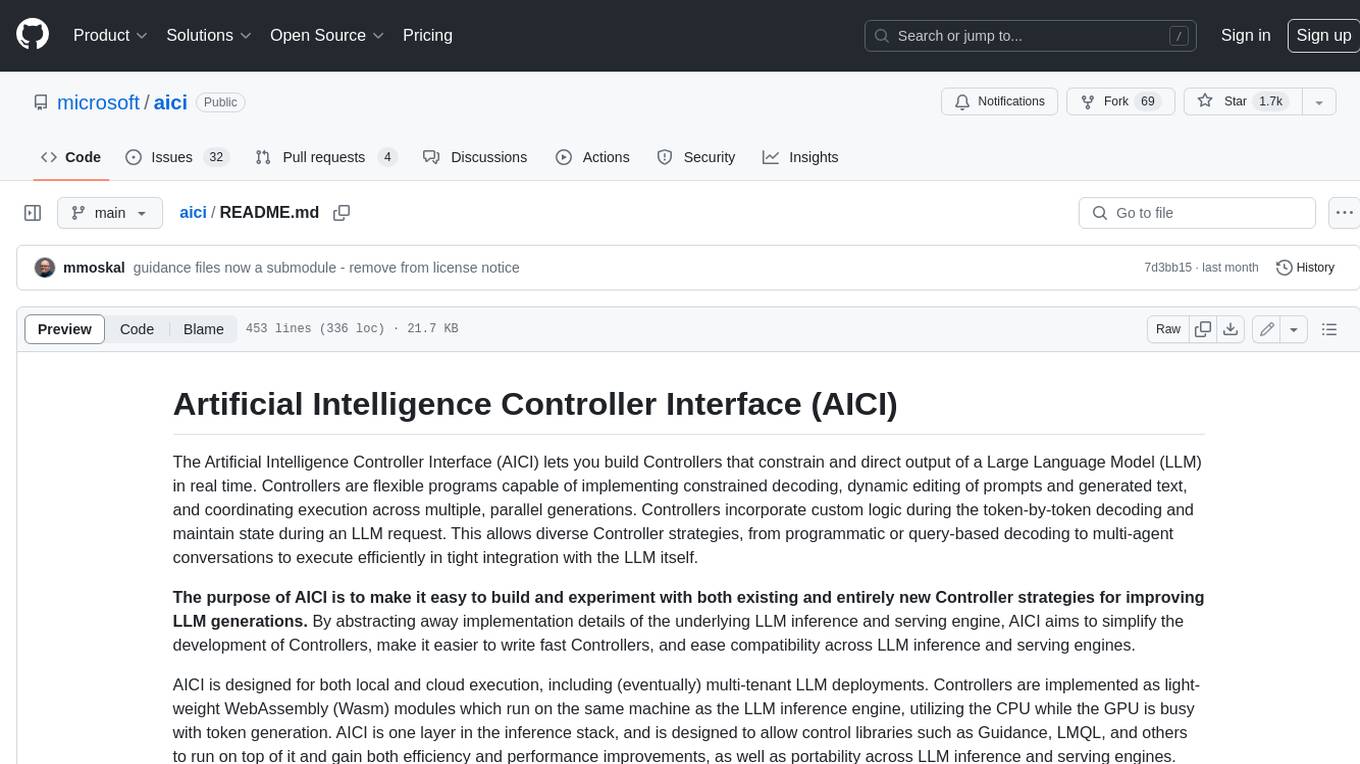
aici
The Artificial Intelligence Controller Interface (AICI) lets you build Controllers that constrain and direct output of a Large Language Model (LLM) in real time. Controllers are flexible programs capable of implementing constrained decoding, dynamic editing of prompts and generated text, and coordinating execution across multiple, parallel generations. Controllers incorporate custom logic during the token-by-token decoding and maintain state during an LLM request. This allows diverse Controller strategies, from programmatic or query-based decoding to multi-agent conversations to execute efficiently in tight integration with the LLM itself.
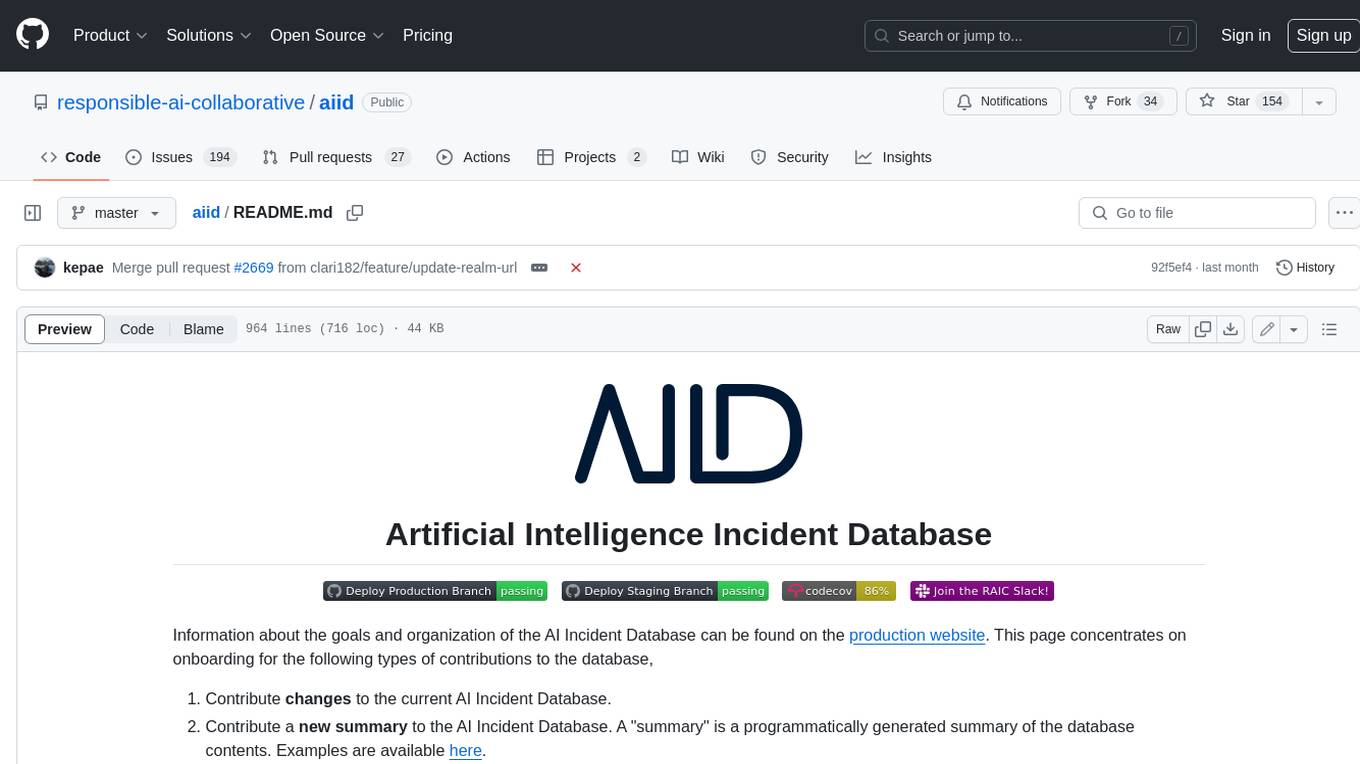
aiid
The Artificial Intelligence Incident Database (AIID) is a collection of incidents involving the development and use of artificial intelligence (AI). The database is designed to help researchers, policymakers, and the public understand the potential risks and benefits of AI, and to inform the development of policies and practices to mitigate the risks and promote the benefits of AI. The AIID is a collaborative project involving researchers from the University of California, Berkeley, the University of Washington, and the University of Toronto.
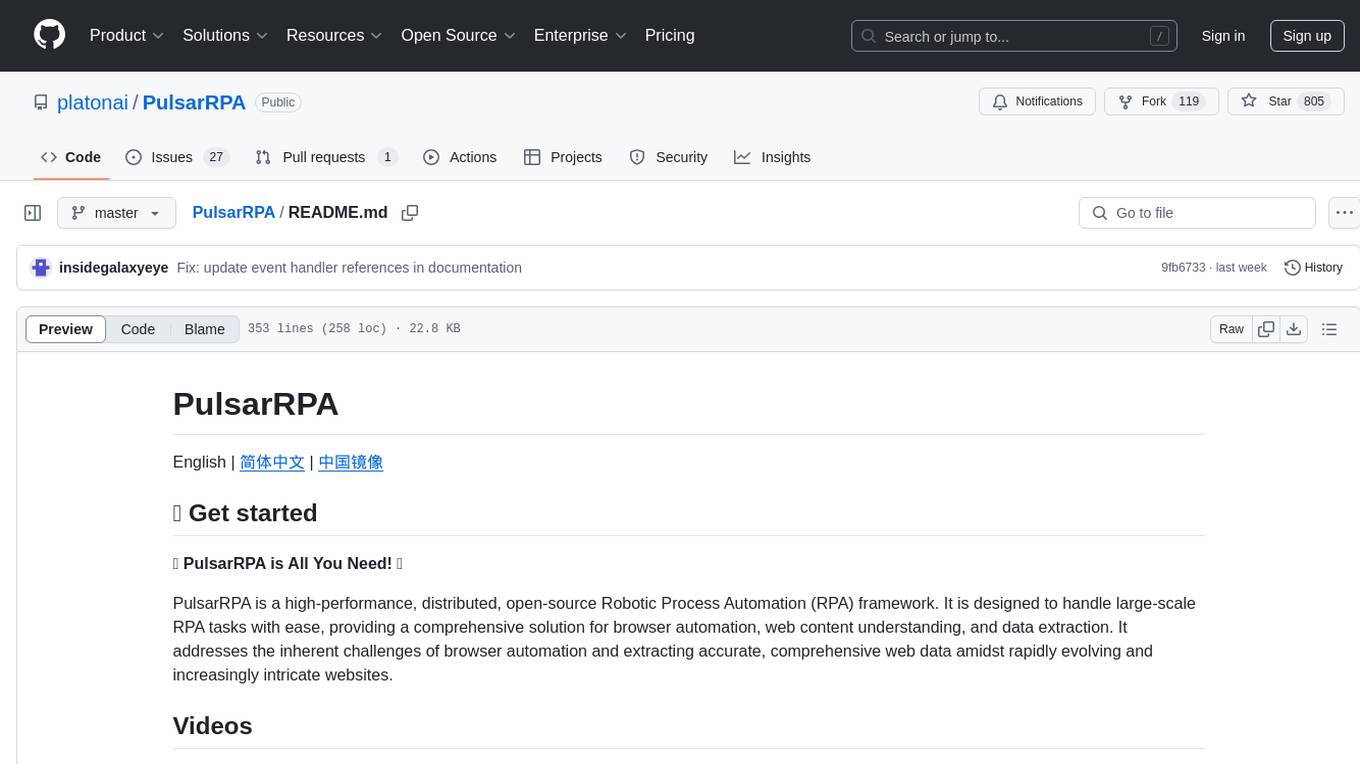
PulsarRPA
PulsarRPA is a high-performance, distributed, open-source Robotic Process Automation (RPA) framework designed to handle large-scale RPA tasks with ease. It provides a comprehensive solution for browser automation, web content understanding, and data extraction. PulsarRPA addresses challenges of browser automation and accurate web data extraction from complex and evolving websites. It incorporates innovative technologies like browser rendering, RPA, intelligent scraping, advanced DOM parsing, and distributed architecture to ensure efficient, accurate, and scalable web data extraction. The tool is open-source, customizable, and supports cutting-edge information extraction technology, making it a preferred solution for large-scale web data extraction.
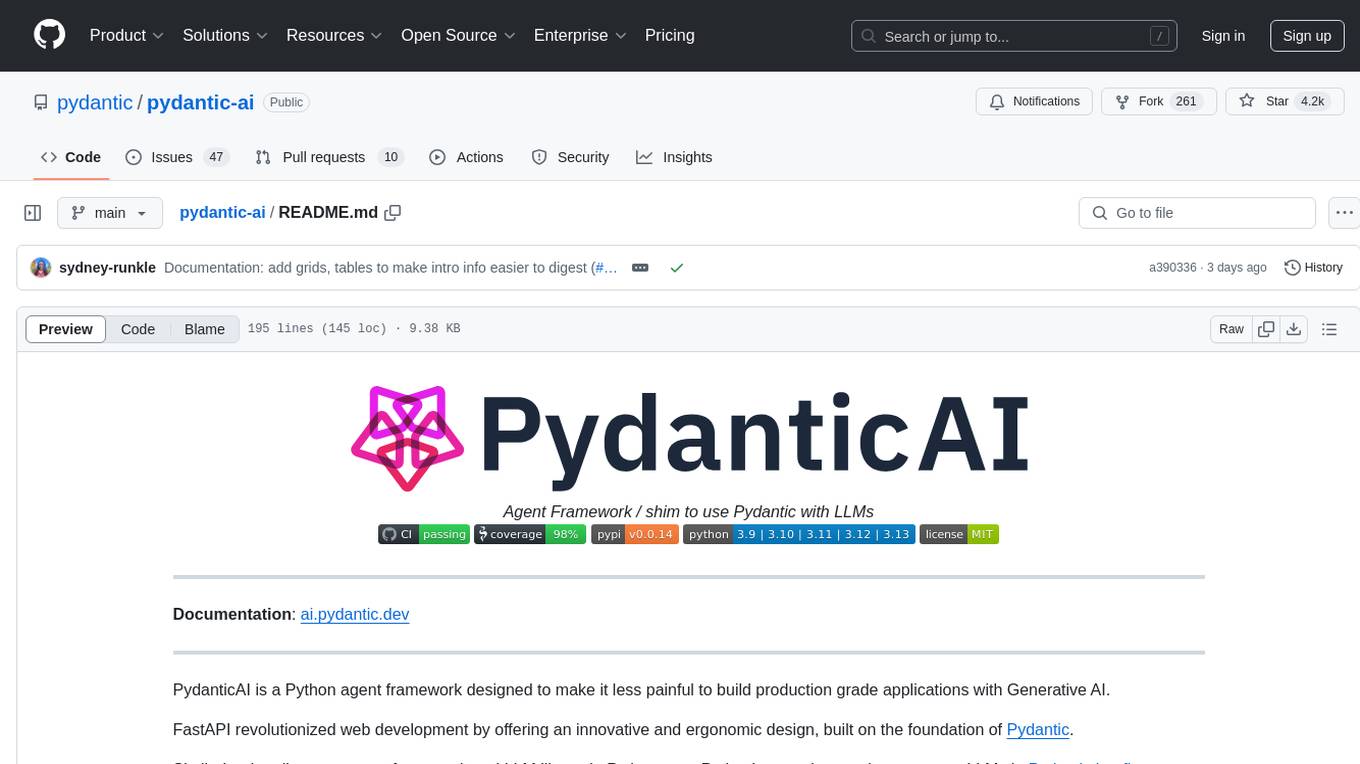
pydantic-ai
PydanticAI is a Python agent framework designed to make it less painful to build production grade applications with Generative AI. It is built by the Pydantic Team and supports various AI models like OpenAI, Anthropic, Gemini, Ollama, Groq, and Mistral. PydanticAI seamlessly integrates with Pydantic Logfire for real-time debugging, performance monitoring, and behavior tracking of LLM-powered applications. It is type-safe, Python-centric, and offers structured responses, dependency injection system, and streamed responses. PydanticAI is in early beta, offering a Python-centric design to apply standard Python best practices in AI-driven projects.
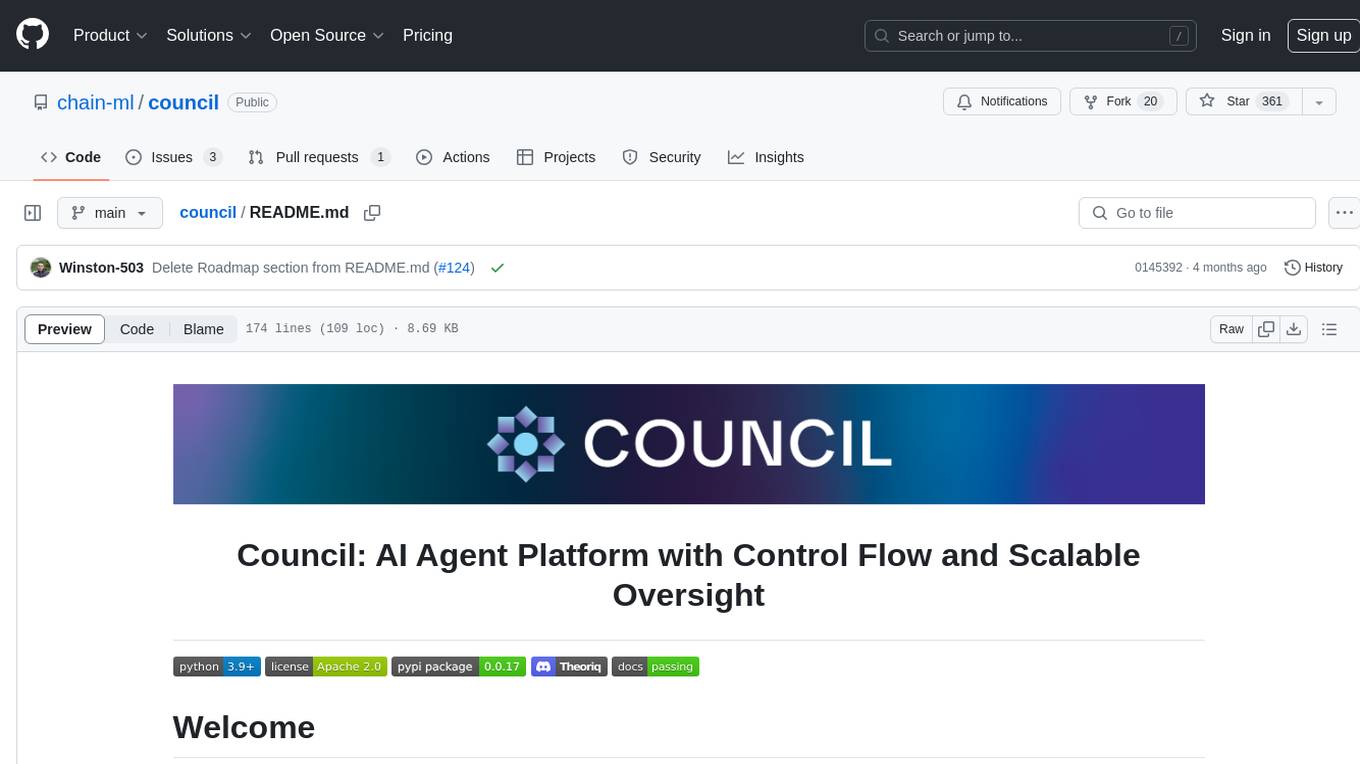
council
Council is an open-source platform designed for the rapid development and deployment of customized generative AI applications using teams of agents. It extends the LLM tool ecosystem by providing advanced control flow and scalable oversight for AI agents. Users can create sophisticated agents with predictable behavior by leveraging Council's powerful approach to control flow using Controllers, Filters, Evaluators, and Budgets. The framework allows for automated routing between agents, comparing, evaluating, and selecting the best results for a task. Council aims to facilitate packaging and deploying agents at scale on multiple platforms while enabling enterprise-grade monitoring and quality control.
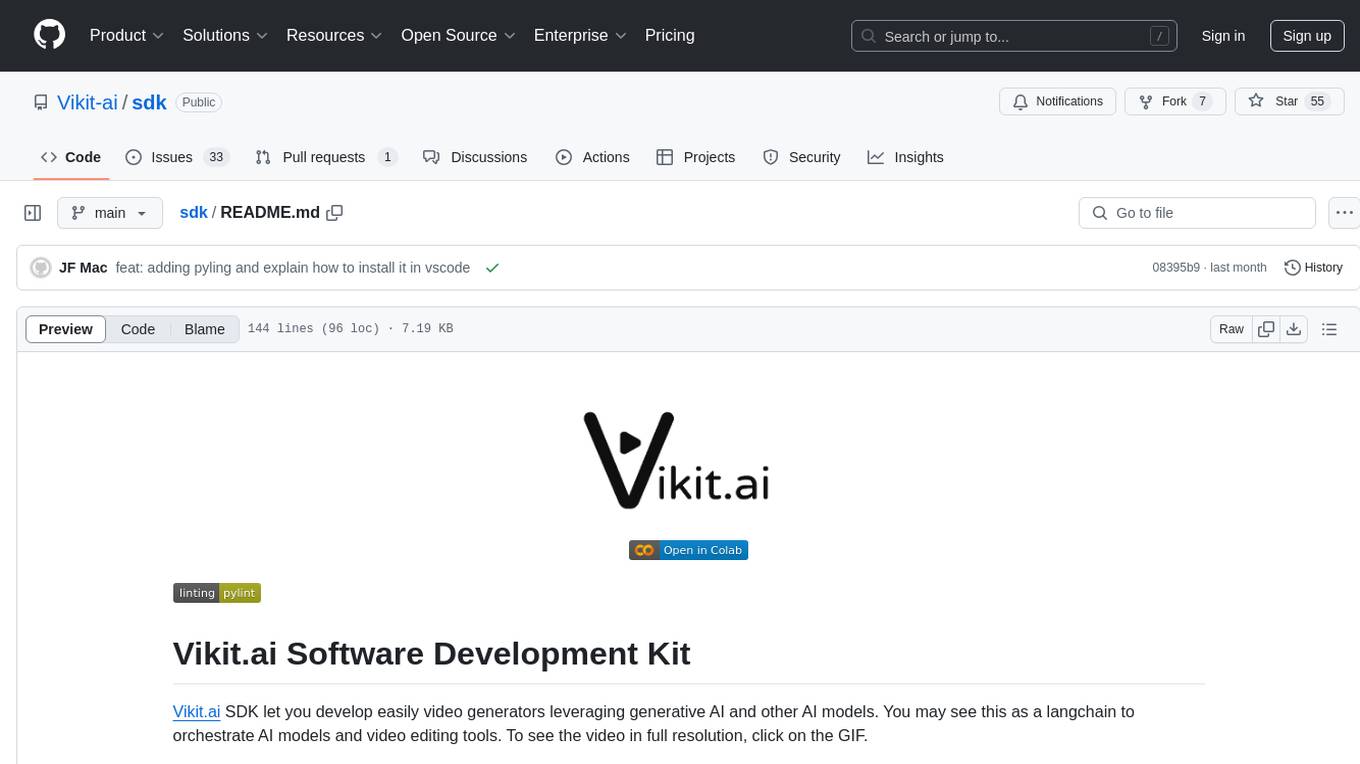
sdk
Vikit.ai SDK is a software development kit that enables easy development of video generators using generative AI and other AI models. It serves as a langchain to orchestrate AI models and video editing tools. The SDK allows users to create videos from text prompts with background music and voice-over narration. It also supports generating composite videos from multiple text prompts. The tool requires Python 3.8+, specific dependencies, and tools like FFMPEG and ImageMagick for certain functionalities. Users can contribute to the project by following the contribution guidelines and standards provided.
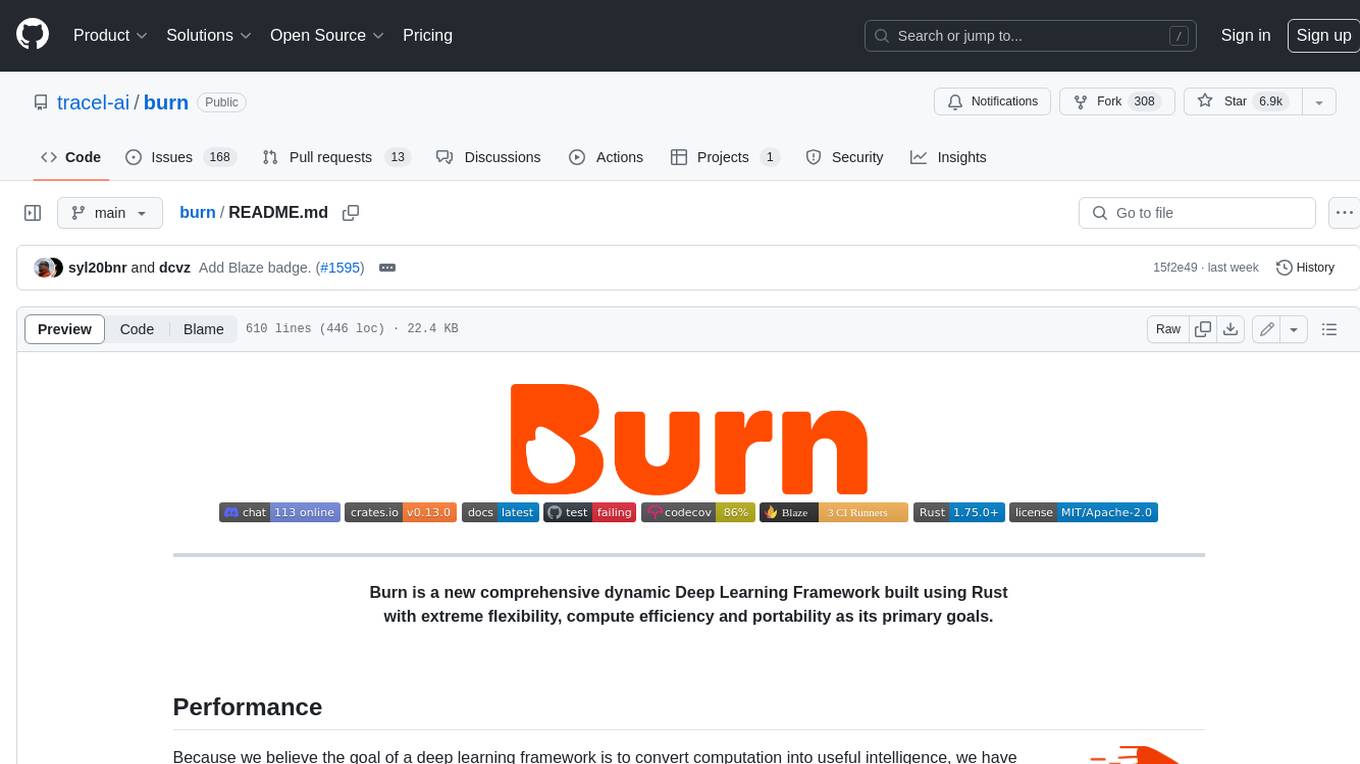
burn
Burn is a new comprehensive dynamic Deep Learning Framework built using Rust with extreme flexibility, compute efficiency and portability as its primary goals.
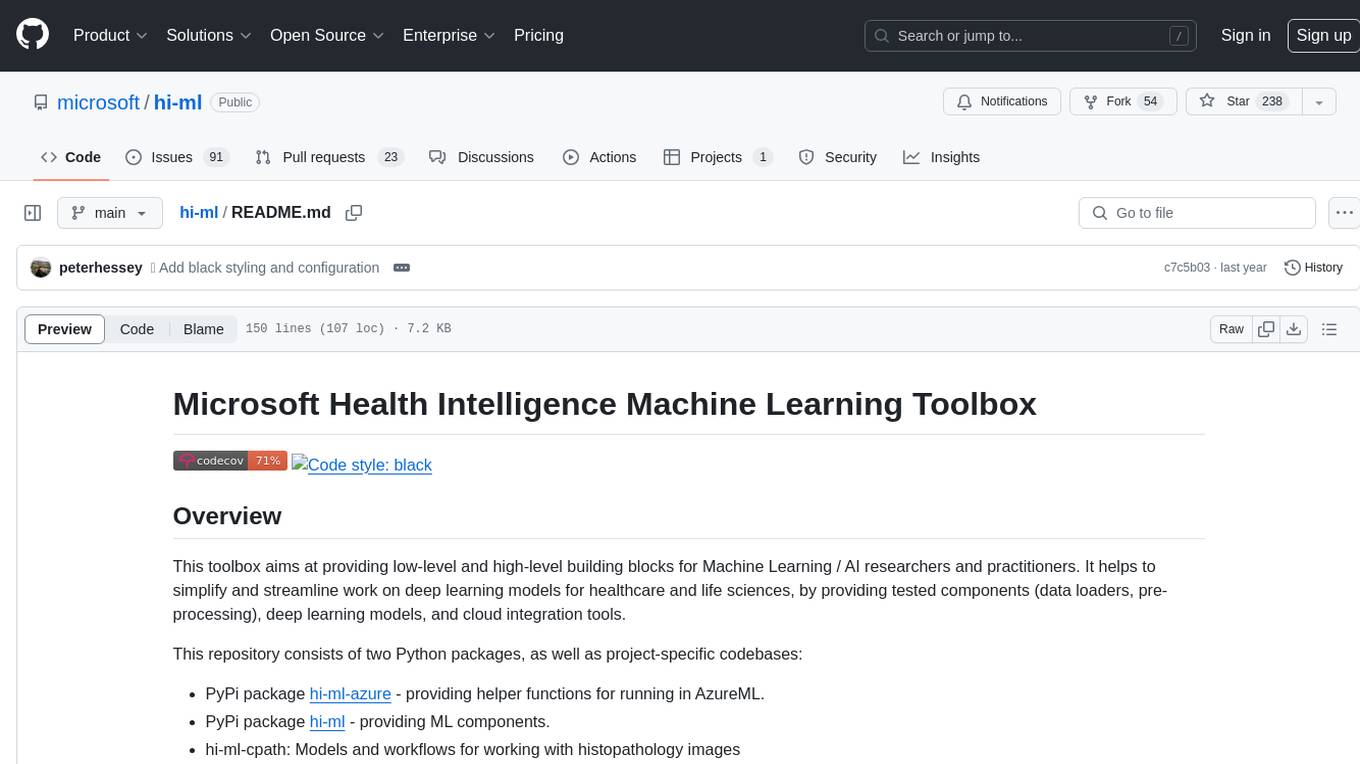
hi-ml
The Microsoft Health Intelligence Machine Learning Toolbox is a repository that provides low-level and high-level building blocks for Machine Learning / AI researchers and practitioners. It simplifies and streamlines work on deep learning models for healthcare and life sciences by offering tested components such as data loaders, pre-processing tools, deep learning models, and cloud integration utilities. The repository includes two Python packages, 'hi-ml-azure' for helper functions in AzureML, 'hi-ml' for ML components, and 'hi-ml-cpath' for models and workflows related to histopathology images.
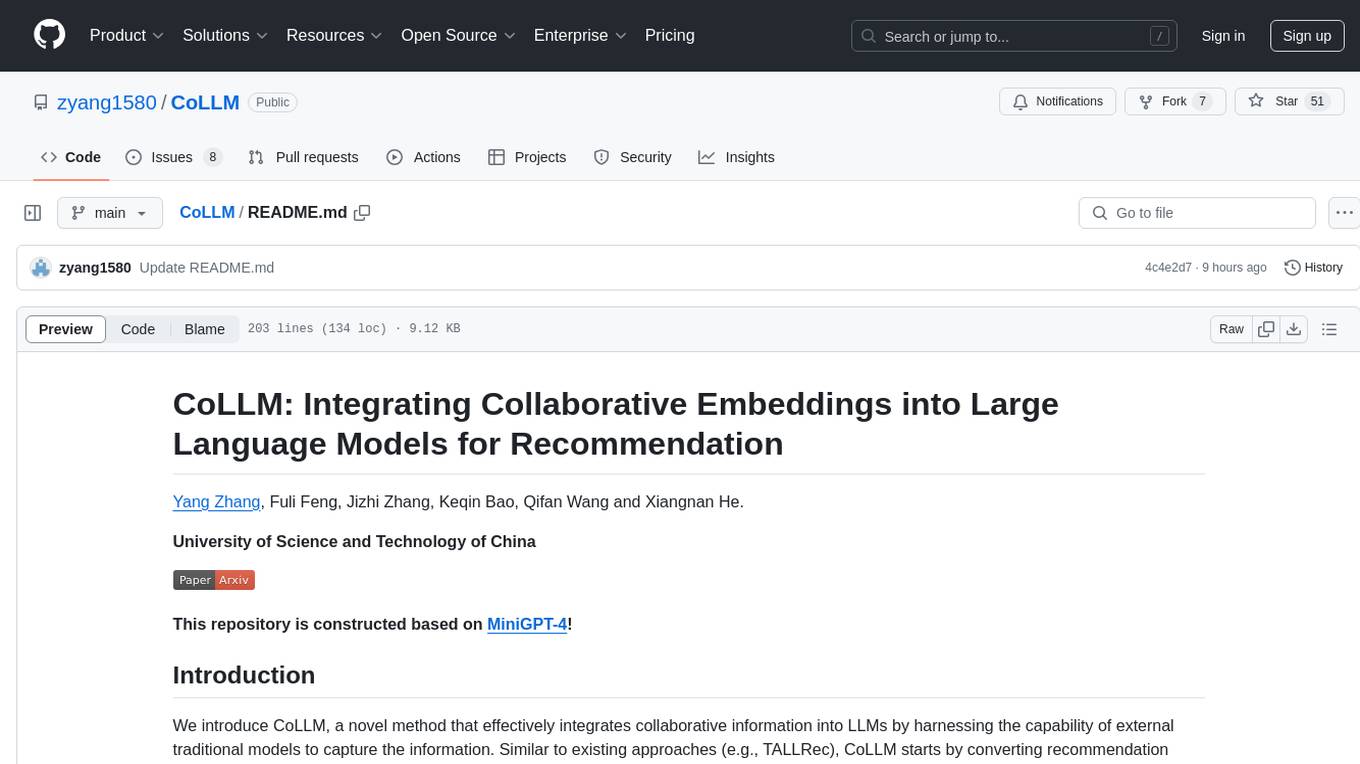
CoLLM
CoLLM is a novel method that integrates collaborative information into Large Language Models (LLMs) for recommendation. It converts recommendation data into language prompts, encodes them with both textual and collaborative information, and uses a two-step tuning method to train the model. The method incorporates user/item ID fields in prompts and employs a conventional collaborative model to generate user/item representations. CoLLM is built upon MiniGPT-4 and utilizes pretrained Vicuna weights for training.
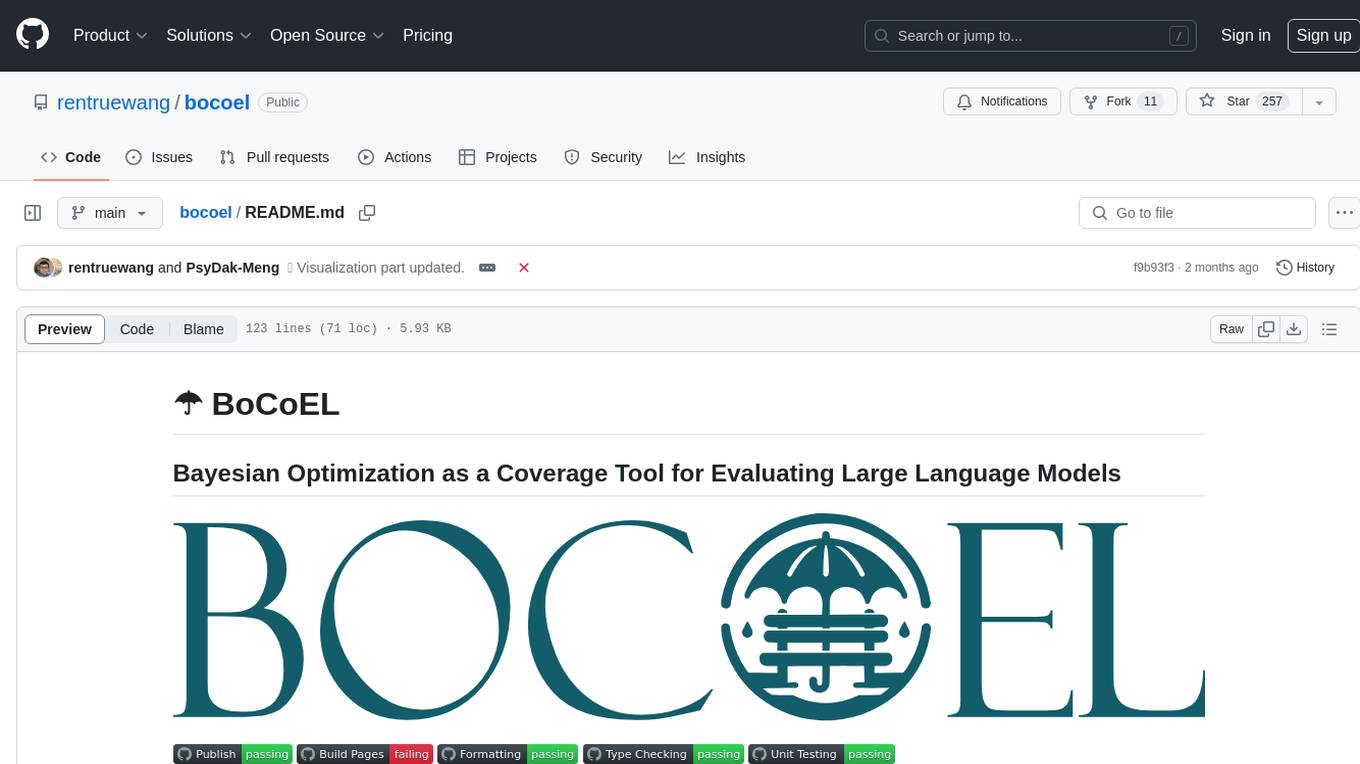
bocoel
BoCoEL is a tool that leverages Bayesian Optimization to efficiently evaluate large language models by selecting a subset of the corpus for evaluation. It encodes individual entries into embeddings, uses Bayesian optimization to select queries, retrieves from the corpus, and provides easily managed evaluations. The tool aims to reduce computation costs during evaluation with a dynamic budget, supporting models like GPT2, Pythia, and LLAMA through integration with Hugging Face transformers and datasets. BoCoEL offers a modular design and efficient representation of the corpus to enhance evaluation quality.
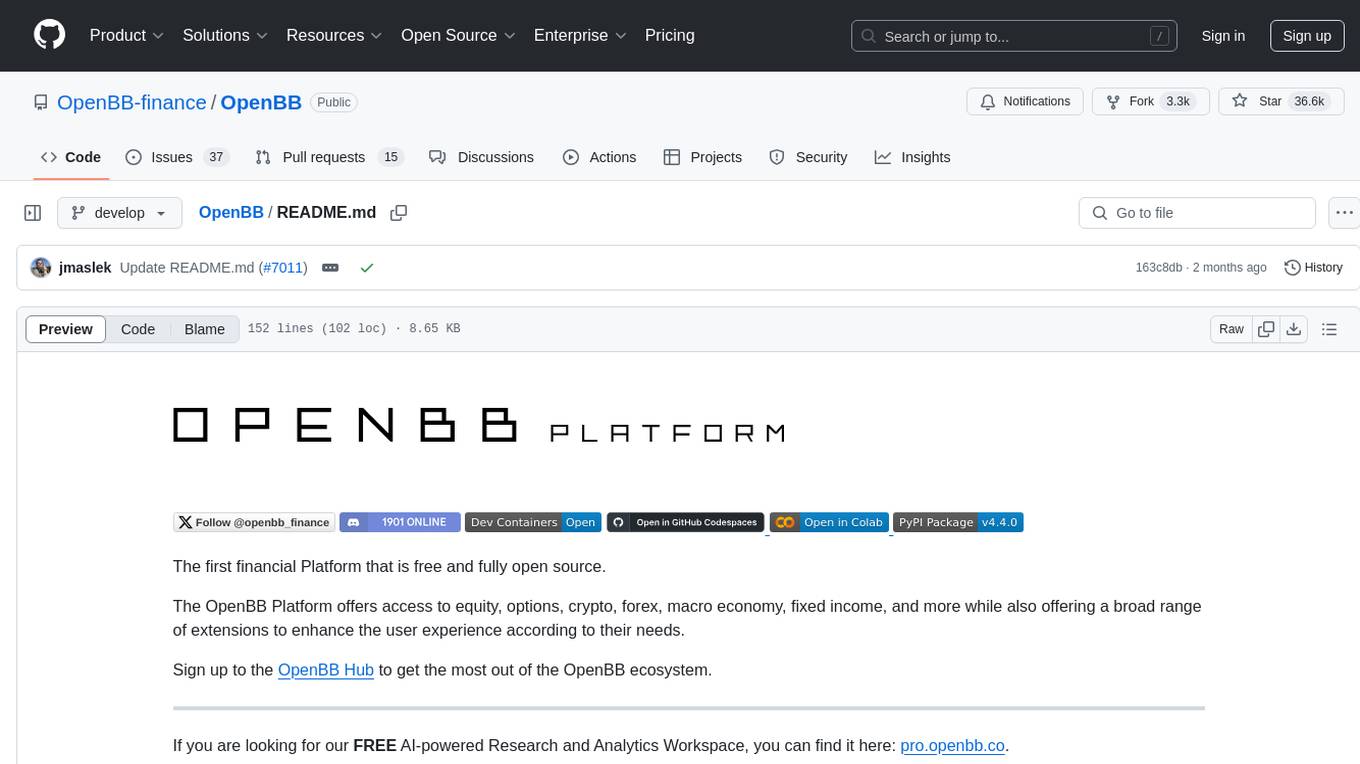
OpenBB
The OpenBB Platform is the first financial platform that is free and fully open source, offering access to equity, options, crypto, forex, macro economy, fixed income, and more. It provides a broad range of extensions to enhance the user experience according to their needs. Users can sign up to the OpenBB Hub to maximize the benefits of the OpenBB ecosystem. Additionally, the platform includes an AI-powered Research and Analytics Workspace for free. There is also an open source AI financial analyst agent available that can access all the data within OpenBB.
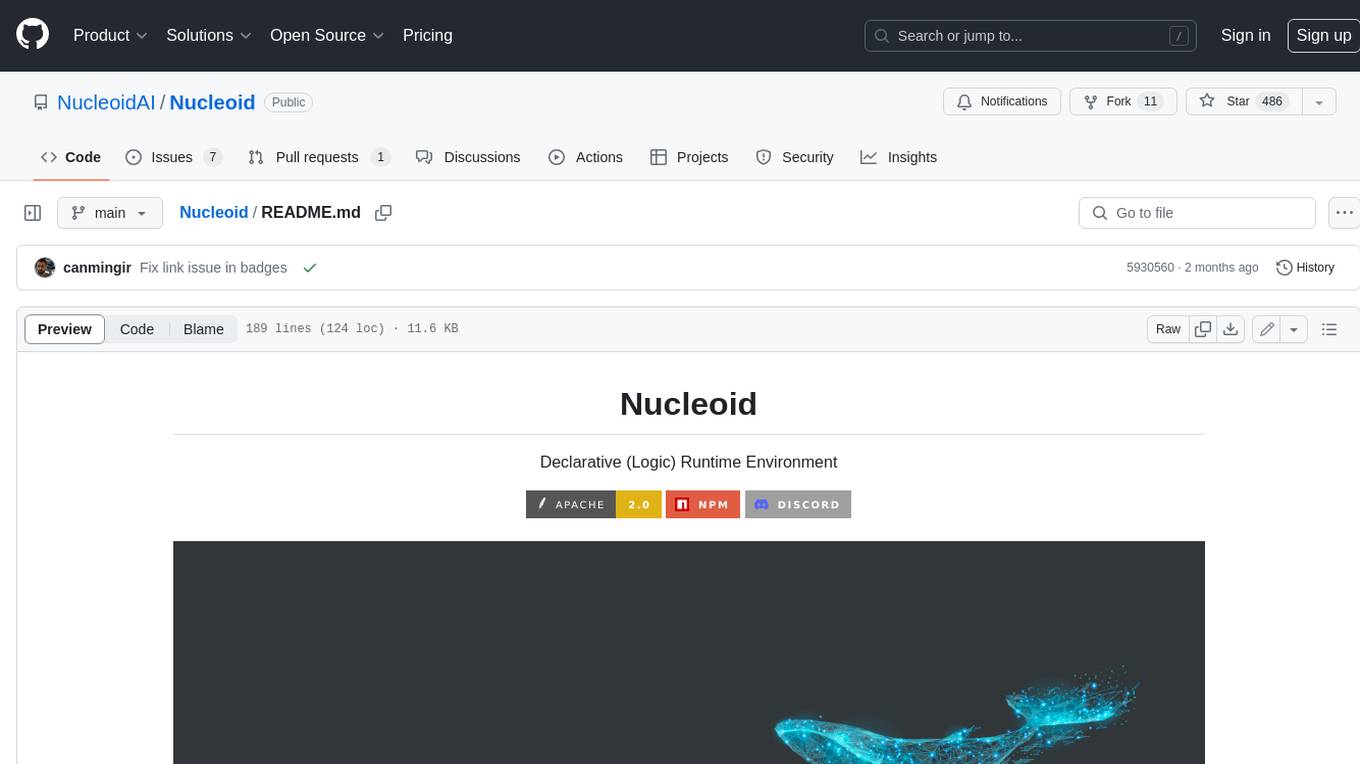
Nucleoid
Nucleoid is a declarative (logic) runtime environment that manages both data and logic under the same runtime. It uses a declarative programming paradigm, which allows developers to focus on the business logic of the application, while the runtime manages the technical details. This allows for faster development and reduces the amount of code that needs to be written. Additionally, the sharding feature can help to distribute the load across multiple instances, which can further improve the performance of the system.
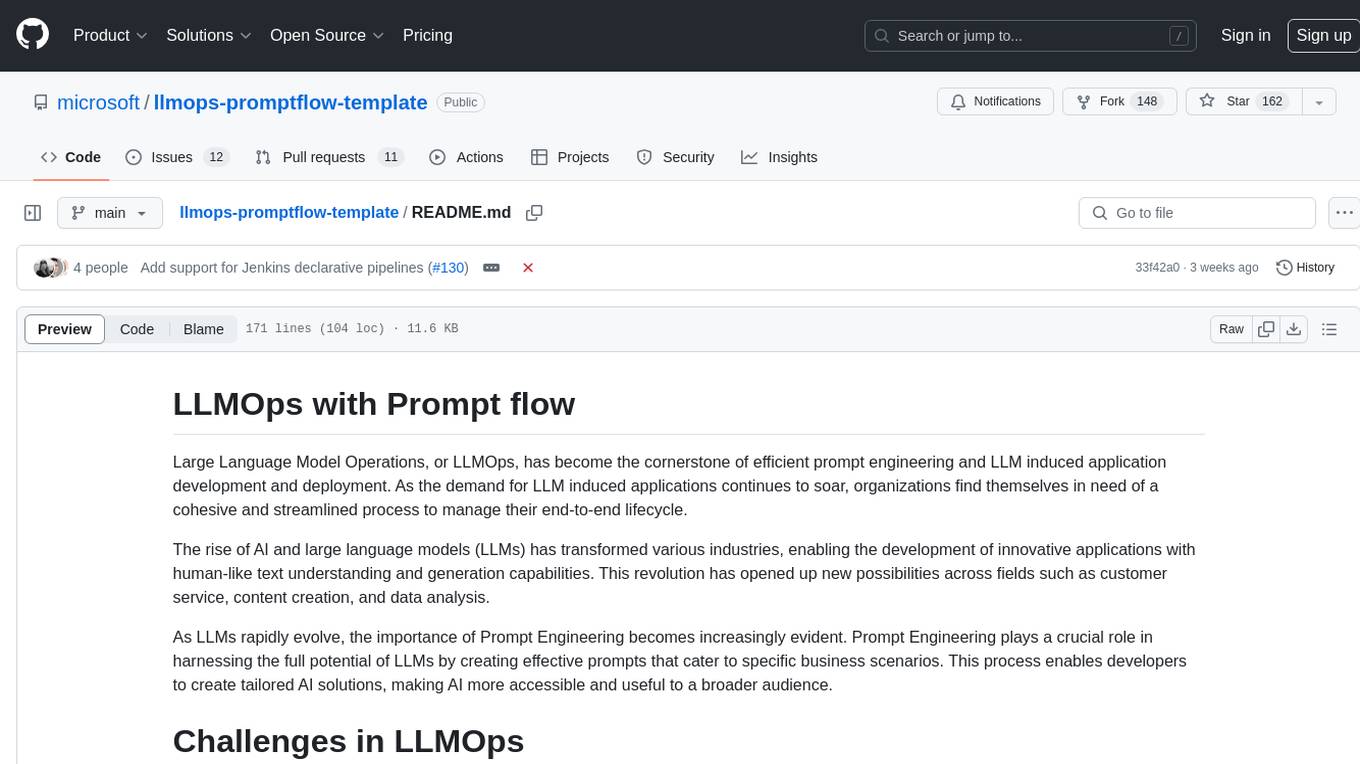
llmops-promptflow-template
LLMOps with Prompt flow is a template and guidance for building LLM-infused apps using Prompt flow. It provides centralized code hosting, lifecycle management, variant and hyperparameter experimentation, A/B deployment, many-to-many dataset/flow relationships, multiple deployment targets, comprehensive reporting, BYOF capabilities, configuration-based development, local prompt experimentation and evaluation, endpoint testing, and optional Human-in-loop validation. The tool is customizable to suit various application needs.
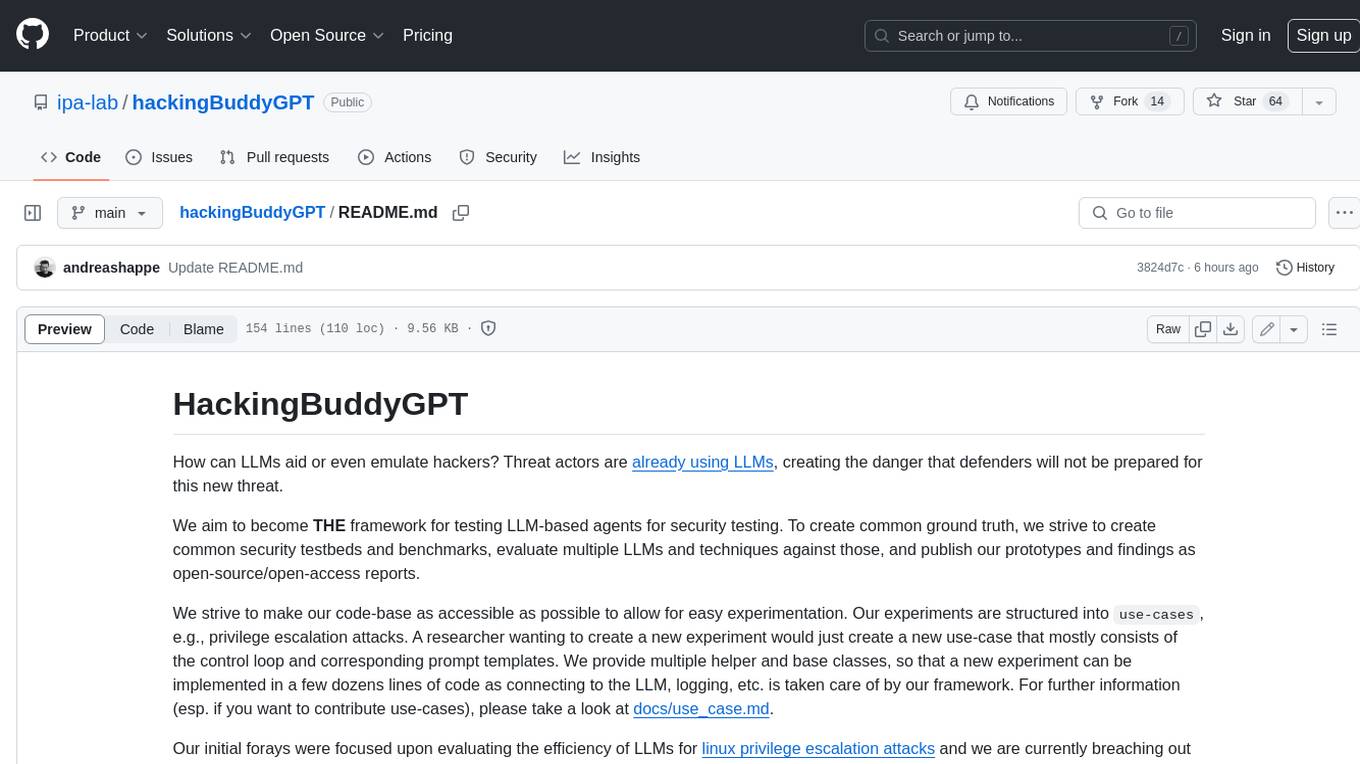
hackingBuddyGPT
hackingBuddyGPT is a framework for testing LLM-based agents for security testing. It aims to create common ground truth by creating common security testbeds and benchmarks, evaluating multiple LLMs and techniques against those, and publishing prototypes and findings as open-source/open-access reports. The initial focus is on evaluating the efficiency of LLMs for Linux privilege escalation attacks, but the framework is being expanded to evaluate the use of LLMs for web penetration-testing and web API testing. hackingBuddyGPT is released as open-source to level the playing field for blue teams against APTs that have access to more sophisticated resources.
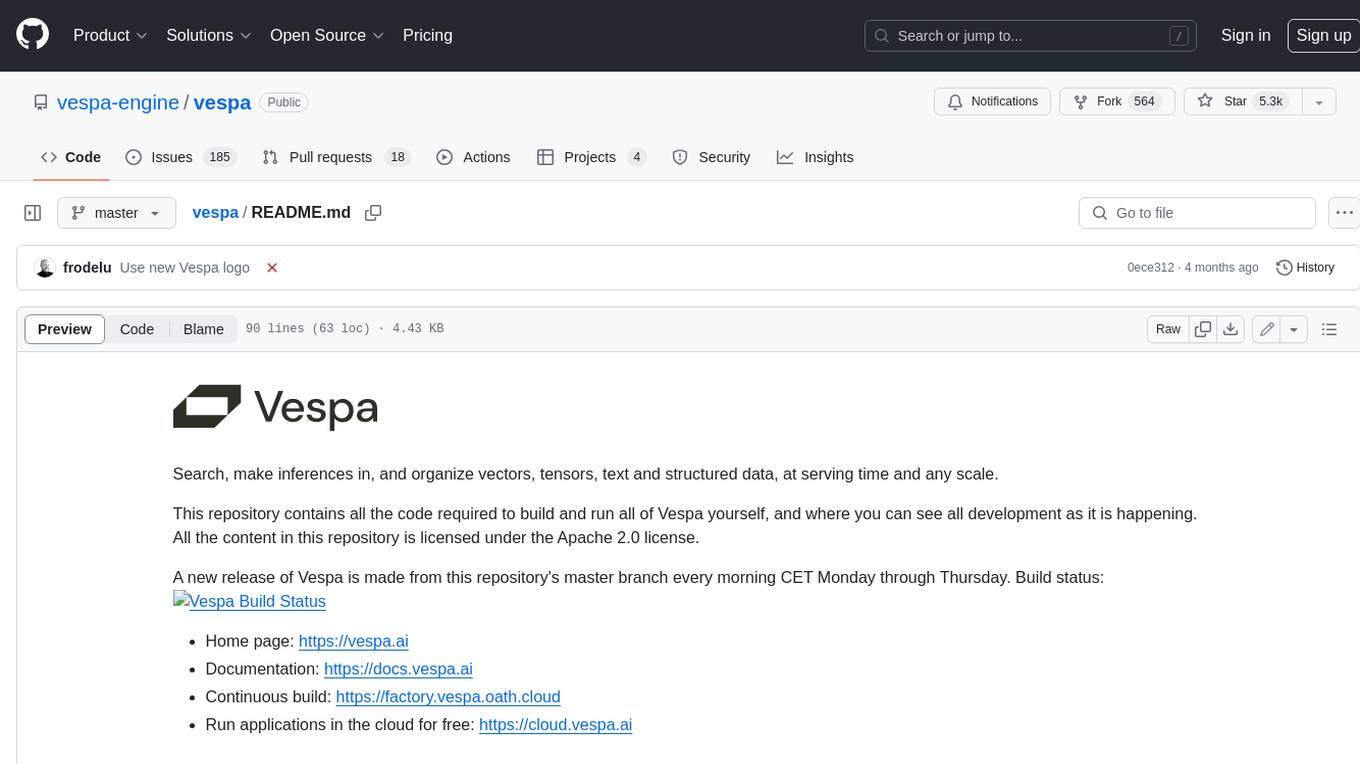
vespa
Vespa is a platform that performs operations such as selecting a subset of data in a large corpus, evaluating machine-learned models over the selected data, organizing and aggregating it, and returning it, typically in less than 100 milliseconds, all while the data corpus is continuously changing. It has been in development for many years and is used on a number of large internet services and apps which serve hundreds of thousands of queries from Vespa per second.
For similar tasks
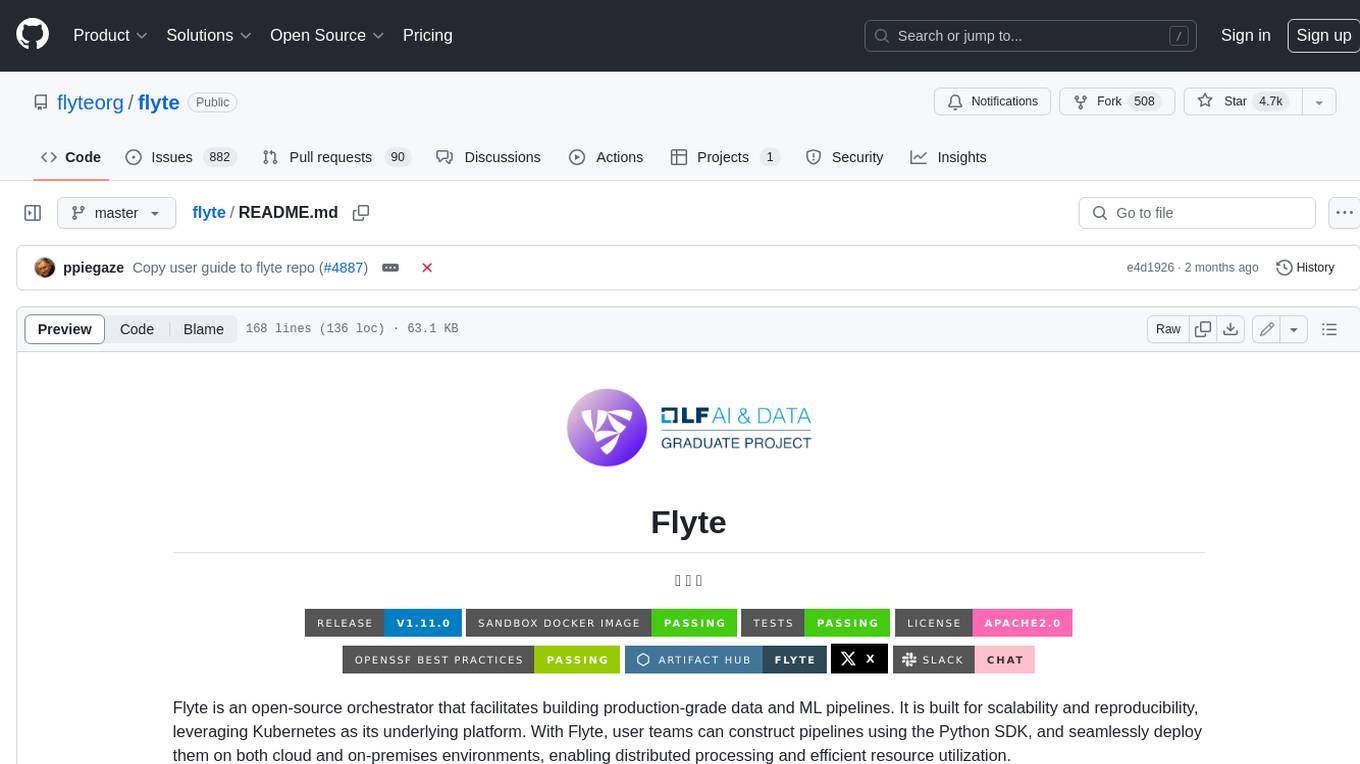
flyte
Flyte is an open-source orchestrator that facilitates building production-grade data and ML pipelines. It is built for scalability and reproducibility, leveraging Kubernetes as its underlying platform. With Flyte, user teams can construct pipelines using the Python SDK, and seamlessly deploy them on both cloud and on-premises environments, enabling distributed processing and efficient resource utilization.

project_alice
Alice is an agentic workflow framework that integrates task execution and intelligent chat capabilities. It provides a flexible environment for creating, managing, and deploying AI agents for various purposes, leveraging a microservices architecture with MongoDB for data persistence. The framework consists of components like APIs, agents, tasks, and chats that interact to produce outputs through files, messages, task results, and URL references. Users can create, test, and deploy agentic solutions in a human-language framework, making it easy to engage with by both users and agents. The tool offers an open-source option, user management, flexible model deployment, and programmatic access to tasks and chats.
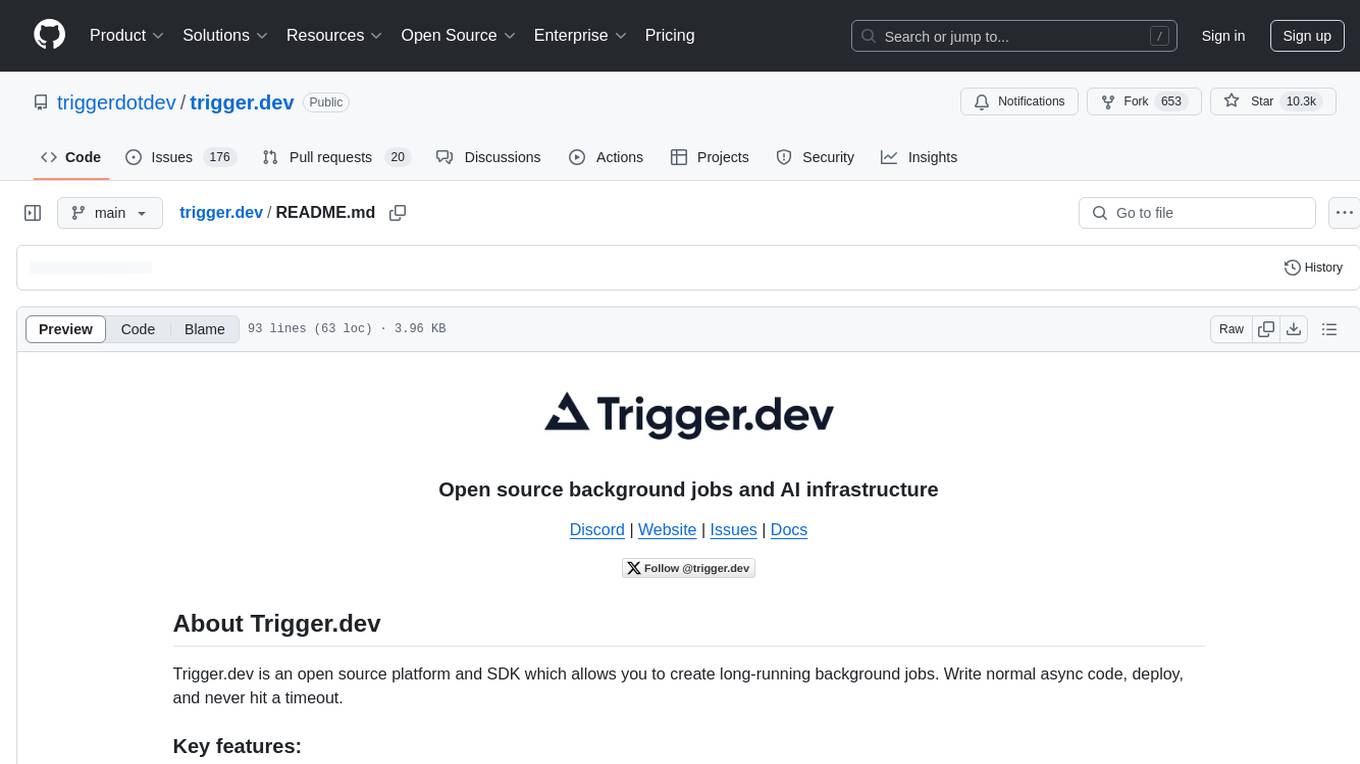
trigger.dev
Trigger.dev is an open source platform and SDK for creating long-running background jobs. It provides features like JavaScript and TypeScript SDK, no timeouts, retries, queues, schedules, observability, React hooks, Realtime API, custom alerts, elastic scaling, and works with existing tech stack. Users can create tasks in their codebase, deploy tasks using the SDK, manage tasks in different environments, and have full visibility of job runs. The platform offers a trace view of every task run for detailed monitoring. Getting started is easy with account creation, project setup, and onboarding instructions. Self-hosting and development guides are available for users interested in contributing or hosting Trigger.dev.

ai-on-gke
This repository contains assets related to AI/ML workloads on Google Kubernetes Engine (GKE). Run optimized AI/ML workloads with Google Kubernetes Engine (GKE) platform orchestration capabilities. A robust AI/ML platform considers the following layers: Infrastructure orchestration that support GPUs and TPUs for training and serving workloads at scale Flexible integration with distributed computing and data processing frameworks Support for multiple teams on the same infrastructure to maximize utilization of resources
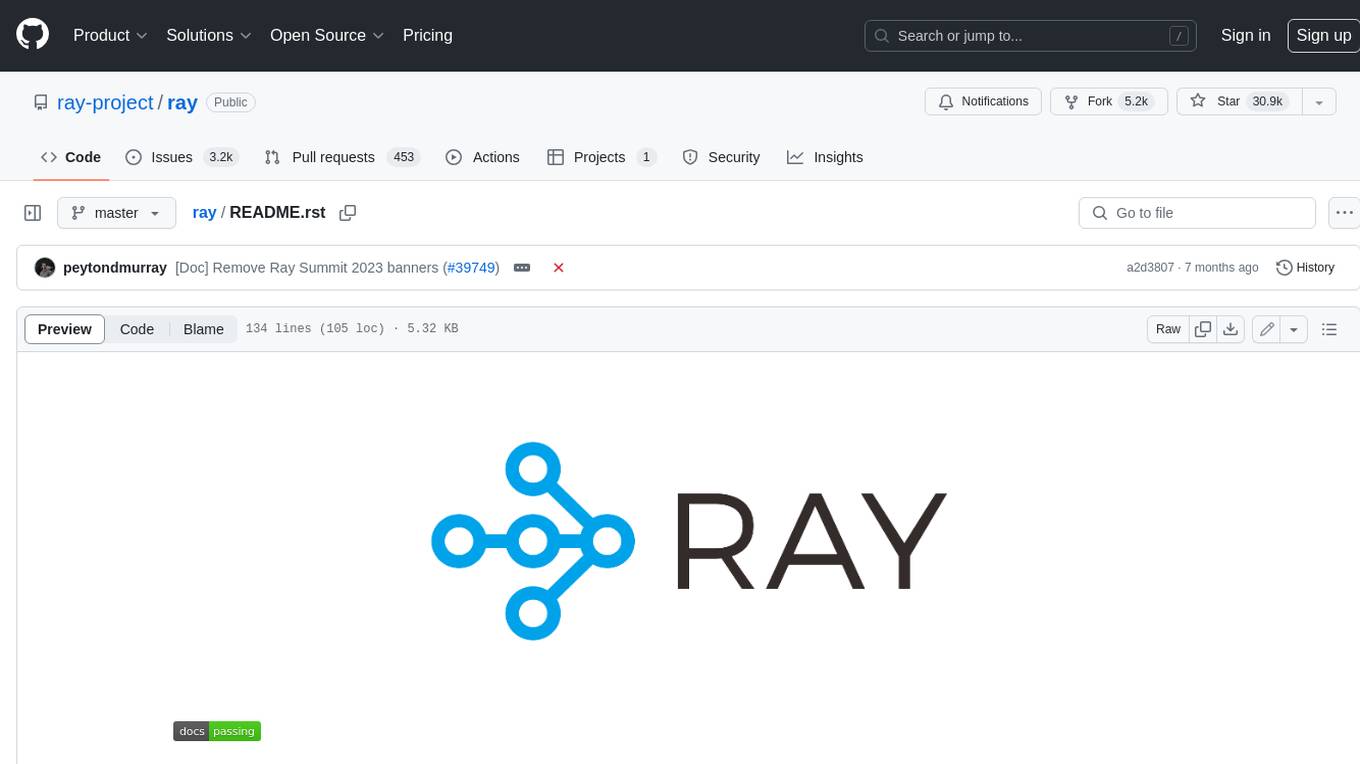
ray
Ray is a unified framework for scaling AI and Python applications. It consists of a core distributed runtime and a set of AI libraries for simplifying ML compute, including Data, Train, Tune, RLlib, and Serve. Ray runs on any machine, cluster, cloud provider, and Kubernetes, and features a growing ecosystem of community integrations. With Ray, you can seamlessly scale the same code from a laptop to a cluster, making it easy to meet the compute-intensive demands of modern ML workloads.

labelbox-python
Labelbox is a data-centric AI platform for enterprises to develop, optimize, and use AI to solve problems and power new products and services. Enterprises use Labelbox to curate data, generate high-quality human feedback data for computer vision and LLMs, evaluate model performance, and automate tasks by combining AI and human-centric workflows. The academic & research community uses Labelbox for cutting-edge AI research.
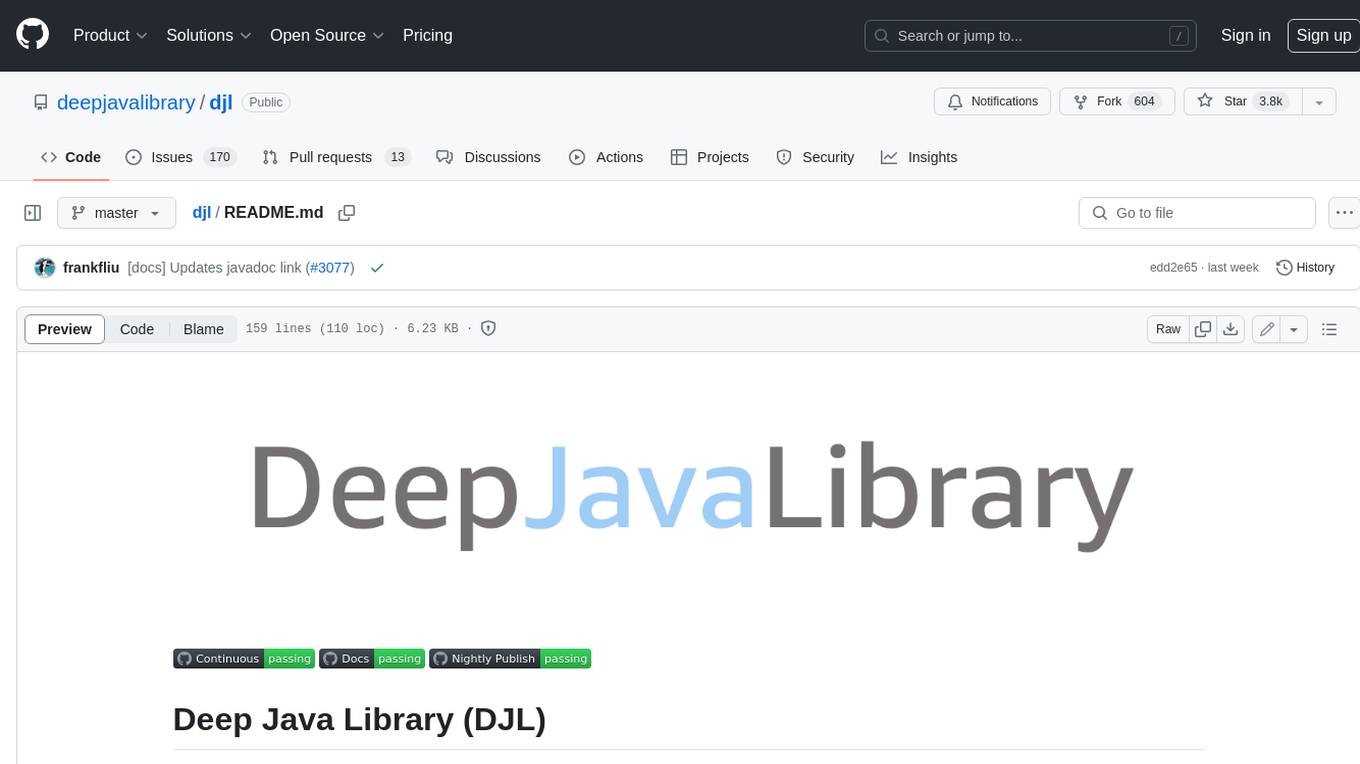
djl
Deep Java Library (DJL) is an open-source, high-level, engine-agnostic Java framework for deep learning. It is designed to be easy to get started with and simple to use for Java developers. DJL provides a native Java development experience and allows users to integrate machine learning and deep learning models with their Java applications. The framework is deep learning engine agnostic, enabling users to switch engines at any point for optimal performance. DJL's ergonomic API interface guides users with best practices to accomplish deep learning tasks, such as running inference and training neural networks.
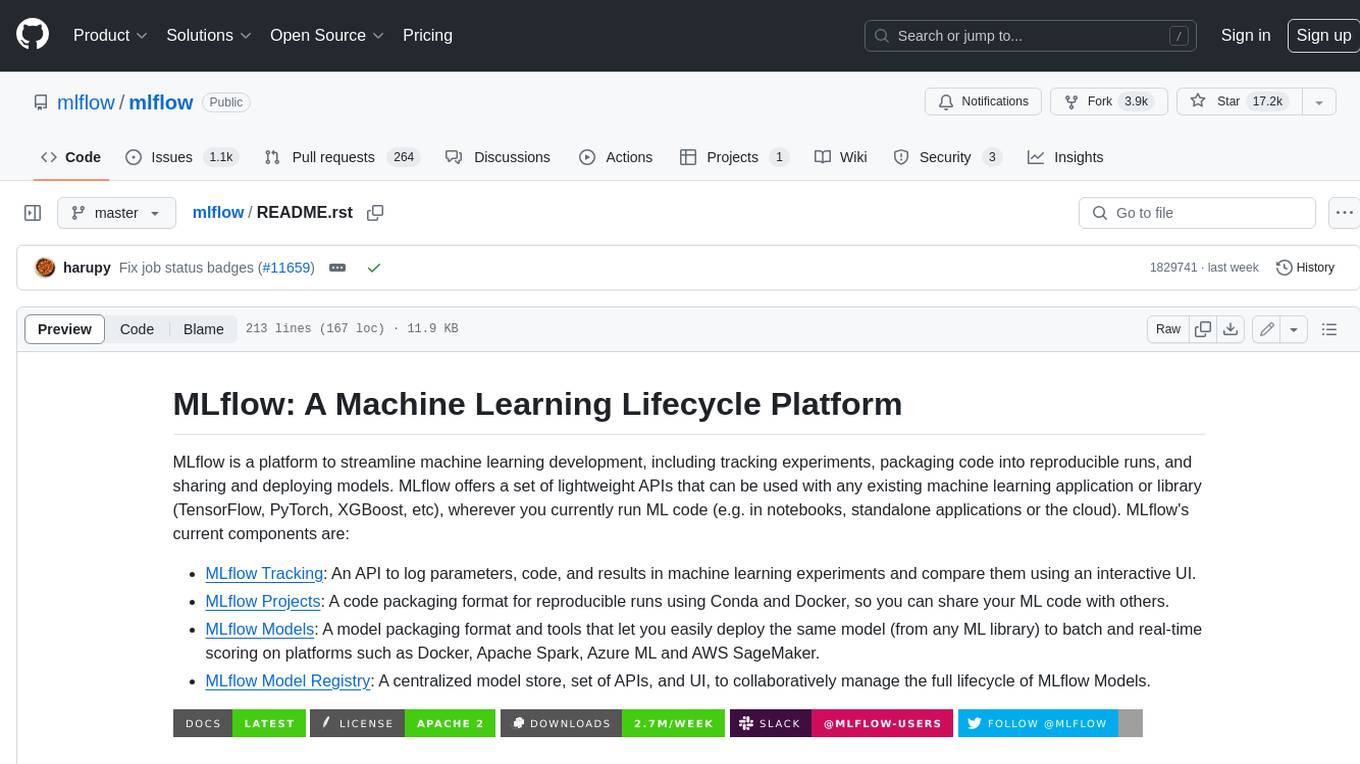
mlflow
MLflow is a platform to streamline machine learning development, including tracking experiments, packaging code into reproducible runs, and sharing and deploying models. MLflow offers a set of lightweight APIs that can be used with any existing machine learning application or library (TensorFlow, PyTorch, XGBoost, etc), wherever you currently run ML code (e.g. in notebooks, standalone applications or the cloud). MLflow's current components are:
* `MLflow Tracking
For similar jobs

sweep
Sweep is an AI junior developer that turns bugs and feature requests into code changes. It automatically handles developer experience improvements like adding type hints and improving test coverage.

teams-ai
The Teams AI Library is a software development kit (SDK) that helps developers create bots that can interact with Teams and Microsoft 365 applications. It is built on top of the Bot Framework SDK and simplifies the process of developing bots that interact with Teams' artificial intelligence capabilities. The SDK is available for JavaScript/TypeScript, .NET, and Python.

ai-guide
This guide is dedicated to Large Language Models (LLMs) that you can run on your home computer. It assumes your PC is a lower-end, non-gaming setup.

classifai
Supercharge WordPress Content Workflows and Engagement with Artificial Intelligence. Tap into leading cloud-based services like OpenAI, Microsoft Azure AI, Google Gemini and IBM Watson to augment your WordPress-powered websites. Publish content faster while improving SEO performance and increasing audience engagement. ClassifAI integrates Artificial Intelligence and Machine Learning technologies to lighten your workload and eliminate tedious tasks, giving you more time to create original content that matters.

chatbot-ui
Chatbot UI is an open-source AI chat app that allows users to create and deploy their own AI chatbots. It is easy to use and can be customized to fit any need. Chatbot UI is perfect for businesses, developers, and anyone who wants to create a chatbot.

BricksLLM
BricksLLM is a cloud native AI gateway written in Go. Currently, it provides native support for OpenAI, Anthropic, Azure OpenAI and vLLM. BricksLLM aims to provide enterprise level infrastructure that can power any LLM production use cases. Here are some use cases for BricksLLM: * Set LLM usage limits for users on different pricing tiers * Track LLM usage on a per user and per organization basis * Block or redact requests containing PIIs * Improve LLM reliability with failovers, retries and caching * Distribute API keys with rate limits and cost limits for internal development/production use cases * Distribute API keys with rate limits and cost limits for students

uAgents
uAgents is a Python library developed by Fetch.ai that allows for the creation of autonomous AI agents. These agents can perform various tasks on a schedule or take action on various events. uAgents are easy to create and manage, and they are connected to a fast-growing network of other uAgents. They are also secure, with cryptographically secured messages and wallets.

griptape
Griptape is a modular Python framework for building AI-powered applications that securely connect to your enterprise data and APIs. It offers developers the ability to maintain control and flexibility at every step. Griptape's core components include Structures (Agents, Pipelines, and Workflows), Tasks, Tools, Memory (Conversation Memory, Task Memory, and Meta Memory), Drivers (Prompt and Embedding Drivers, Vector Store Drivers, Image Generation Drivers, Image Query Drivers, SQL Drivers, Web Scraper Drivers, and Conversation Memory Drivers), Engines (Query Engines, Extraction Engines, Summary Engines, Image Generation Engines, and Image Query Engines), and additional components (Rulesets, Loaders, Artifacts, Chunkers, and Tokenizers). Griptape enables developers to create AI-powered applications with ease and efficiency.






